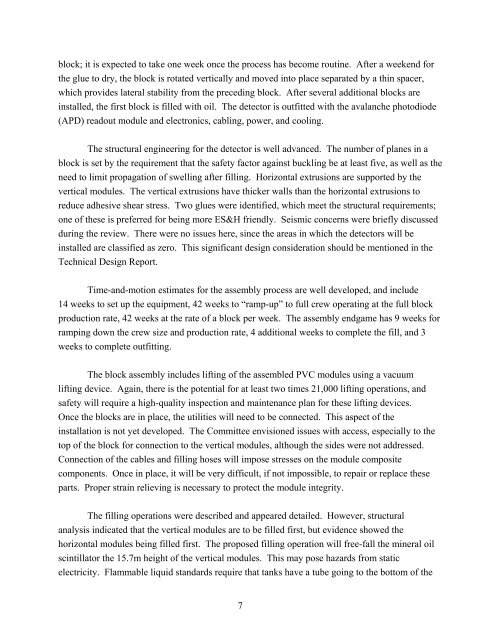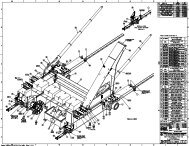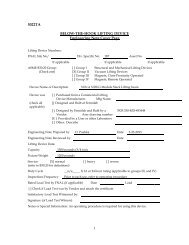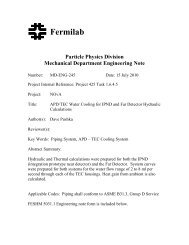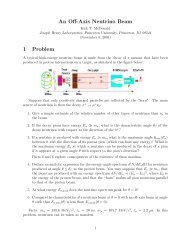NuMi Off-Axis Neutrino Appearance - NOVA Document Database ...
NuMi Off-Axis Neutrino Appearance - NOVA Document Database ...
NuMi Off-Axis Neutrino Appearance - NOVA Document Database ...
Create successful ePaper yourself
Turn your PDF publications into a flip-book with our unique Google optimized e-Paper software.
lock; it is expected to take one week once the process has become routine. After a weekend for<br />
the glue to dry, the block is rotated vertically and moved into place separated by a thin spacer,<br />
which provides lateral stability from the preceding block. After several additional blocks are<br />
installed, the first block is filled with oil. The detector is outfitted with the avalanche photodiode<br />
(APD) readout module and electronics, cabling, power, and cooling.<br />
The structural engineering for the detector is well advanced. The number of planes in a<br />
block is set by the requirement that the safety factor against buckling be at least five, as well as the<br />
need to limit propagation of swelling after filling. Horizontal extrusions are supported by the<br />
vertical modules. The vertical extrusions have thicker walls than the horizontal extrusions to<br />
reduce adhesive shear stress. Two glues were identified, which meet the structural requirements;<br />
one of these is preferred for being more ES&H friendly. Seismic concerns were briefly discussed<br />
during the review. There were no issues here, since the areas in which the detectors will be<br />
installed are classified as zero. This significant design consideration should be mentioned in the<br />
Technical Design Report.<br />
Time-and-motion estimates for the assembly process are well developed, and include<br />
14 weeks to set up the equipment, 42 weeks to “ramp-up” to full crew operating at the full block<br />
production rate, 42 weeks at the rate of a block per week. The assembly endgame has 9 weeks for<br />
ramping down the crew size and production rate, 4 additional weeks to complete the fill, and 3<br />
weeks to complete outfitting.<br />
The block assembly includes lifting of the assembled PVC modules using a vacuum<br />
lifting device. Again, there is the potential for at least two times 21,000 lifting operations, and<br />
safety will require a high-quality inspection and maintenance plan for these lifting devices.<br />
Once the blocks are in place, the utilities will need to be connected. This aspect of the<br />
installation is not yet developed. The Committee envisioned issues with access, especially to the<br />
top of the block for connection to the vertical modules, although the sides were not addressed.<br />
Connection of the cables and filling hoses will impose stresses on the module composite<br />
components. Once in place, it will be very difficult, if not impossible, to repair or replace these<br />
parts. Proper strain relieving is necessary to protect the module integrity.<br />
The filling operations were described and appeared detailed. However, structural<br />
analysis indicated that the vertical modules are to be filled first, but evidence showed the<br />
horizontal modules being filled first. The proposed filling operation will free-fall the mineral oil<br />
scintillator the 15.7m height of the vertical modules. This may pose hazards from static<br />
electricity. Flammable liquid standards require that tanks have a tube going to the bottom of the<br />
7


